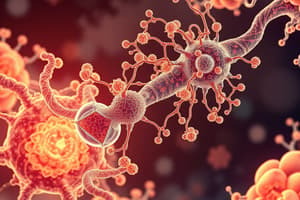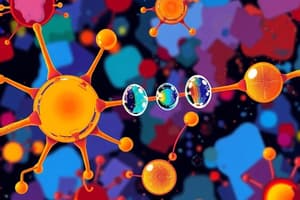Podcast
Questions and Answers
What immediate effect does a ligand binding to a receptor typically cause?
What immediate effect does a ligand binding to a receptor typically cause?
- Inhibition of receptor activity
- Conformational change in the receptor (correct)
- Transcriptional silencing in the nucleus
- Degradation of the ligand
Which factor is essential for extended cell-cell interactions during signal transduction?
Which factor is essential for extended cell-cell interactions during signal transduction?
- Increased binding affinity (correct)
- High lipid solubility of ligands
- Low receptor density
- Rapid degradation of cytokines
What is true about T-cell receptors (TCR)?
What is true about T-cell receptors (TCR)?
- They do not participate in immune response
- They recognize foreign or self-peptides presented on MHC molecules (correct)
- They are only found in secreted form
- They can bind to carbohydrates
What is a characteristic of secreted immunoglobulins?
What is a characteristic of secreted immunoglobulins?
Which of the following benefits is associated with multimerization of receptors?
Which of the following benefits is associated with multimerization of receptors?
What primarily explains the increase in strength of receptor-ligand interactions in immunology?
What primarily explains the increase in strength of receptor-ligand interactions in immunology?
Which statement correctly describes receptor expression during an infection?
Which statement correctly describes receptor expression during an infection?
Which of the following is NOT a contributing factor to increased avidity in receptor-ligand interactions?
Which of the following is NOT a contributing factor to increased avidity in receptor-ligand interactions?
What are the three main transcription factors involved in T-cell activation?
What are the three main transcription factors involved in T-cell activation?
What is one mechanism through which receptor valency increases avidity?
What is one mechanism through which receptor valency increases avidity?
Which class does the cytokine IFN-γ belong to?
Which class does the cytokine IFN-γ belong to?
What is the main function of chemokines like IL-8 and CCL2?
What is the main function of chemokines like IL-8 and CCL2?
Which of the following cytokines is NOT a member of the interleukin family?
Which of the following cytokines is NOT a member of the interleukin family?
The primary role of IL-17 family members is to enhance which of the following?
The primary role of IL-17 family members is to enhance which of the following?
Which of the following cytokines is involved in hematopoiesis?
Which of the following cytokines is involved in hematopoiesis?
What role do co-receptors play in immune system receptor interactions?
What role do co-receptors play in immune system receptor interactions?
Which of the following statements about antibody structure is correct?
Which of the following statements about antibody structure is correct?
Which immunoglobulin heavy chain corresponds to the IgE class?
Which immunoglobulin heavy chain corresponds to the IgE class?
What is the function of glycosylation in antibodies?
What is the function of glycosylation in antibodies?
Which characteristic is shared by both T-cell receptors (TCRs) and B-cell receptors (BCRs)?
Which characteristic is shared by both T-cell receptors (TCRs) and B-cell receptors (BCRs)?
Which T-cell receptor subtype is more common?
Which T-cell receptor subtype is more common?
What segment is found in membrane-bound antibodies but not in secreted antibodies?
What segment is found in membrane-bound antibodies but not in secreted antibodies?
What is the role of the CD3 complex in T-cell receptors?
What is the role of the CD3 complex in T-cell receptors?
What is the role of IL-1 in the immune response?
What is the role of IL-1 in the immune response?
Which family of cytokines is primarily involved in antiviral responses?
Which family of cytokines is primarily involved in antiviral responses?
Which statement about Class I cytokines is true?
Which statement about Class I cytokines is true?
What is the primary function of TNF-α?
What is the primary function of TNF-α?
What type of immune cells primarily secrete Type I interferons?
What type of immune cells primarily secrete Type I interferons?
What is the function of TNF-β (lymphotoxin-α)?
What is the function of TNF-β (lymphotoxin-α)?
Which cytokines are predominantly recognized by the common receptor subunit γc?
Which cytokines are predominantly recognized by the common receptor subunit γc?
Which of the following cytokines is classified as a Type II interferon?
Which of the following cytokines is classified as a Type II interferon?
What is the role of BAFF and APRIL in the immune system?
What is the role of BAFF and APRIL in the immune system?
Which of the following statements about IL-17 family cytokines is true?
Which of the following statements about IL-17 family cytokines is true?
How do chemokines affect leukocyte behavior?
How do chemokines affect leukocyte behavior?
What is the significance of tyrosine phosphorylation in cell signaling?
What is the significance of tyrosine phosphorylation in cell signaling?
What is a key characteristic of chemokine receptors?
What is a key characteristic of chemokine receptors?
What is the consequence of increasing receptor expression on a target cell?
What is the consequence of increasing receptor expression on a target cell?
What role does the CD40 Ligand (CD40L) play in the immune response?
What role does the CD40 Ligand (CD40L) play in the immune response?
What is a defining feature of most signaling pathways in cells?
What is a defining feature of most signaling pathways in cells?
Flashcards
Affinity
Affinity
The strength of a single bond between a receptor and its ligand.
Avidity
Avidity
The overall strength resulting from multiple bonds between a receptor and its ligand. Essentially, the collective strength of many weak bonds.
Valency
Valency
The number of binding sites on a receptor or ligand. More binding sites mean more potential interactions.
Receptor Mobility (Space)
Receptor Mobility (Space)
Signup and view all the flashcards
Receptor Expression (Time)
Receptor Expression (Time)
Signup and view all the flashcards
Ligand-induced conformational change
Ligand-induced conformational change
Signup and view all the flashcards
Receptor dimerization and clustering
Receptor dimerization and clustering
Signup and view all the flashcards
Signal transduction
Signal transduction
Signup and view all the flashcards
Receptor relocation
Receptor relocation
Signup and view all the flashcards
B-cell receptor (BCR)
B-cell receptor (BCR)
Signup and view all the flashcards
Cytokine Family
Cytokine Family
Signup and view all the flashcards
Hematopoietin Cytokine Family
Hematopoietin Cytokine Family
Signup and view all the flashcards
Interferon Cytokine Family
Interferon Cytokine Family
Signup and view all the flashcards
Tumor Necrosis Factor Family
Tumor Necrosis Factor Family
Signup and view all the flashcards
Interleukin-17 Family
Interleukin-17 Family
Signup and view all the flashcards
Co-receptors
Co-receptors
Signup and view all the flashcards
Why are co-receptors important?
Why are co-receptors important?
Signup and view all the flashcards
What is an immunoglobulin?
What is an immunoglobulin?
Signup and view all the flashcards
What are the Ig Isotypes?
What are the Ig Isotypes?
Signup and view all the flashcards
How does the hinge region of immunoglobulin function?
How does the hinge region of immunoglobulin function?
Signup and view all the flashcards
What is a BCR?
What is a BCR?
Signup and view all the flashcards
What is a TCR?
What is a TCR?
Signup and view all the flashcards
What is the function of the CD3 complex?
What is the function of the CD3 complex?
Signup and view all the flashcards
IL-1 Family
IL-1 Family
Signup and view all the flashcards
Class 1 Cytokines
Class 1 Cytokines
Signup and view all the flashcards
Type I Interferons (IFN-α and IFN-β)
Type I Interferons (IFN-α and IFN-β)
Signup and view all the flashcards
Type II Interferon (IFN-γ)
Type II Interferon (IFN-γ)
Signup and view all the flashcards
Type III Interferons (IFN-λ)
Type III Interferons (IFN-λ)
Signup and view all the flashcards
TNF Family (Tumor Necrosis Factor)
TNF Family (Tumor Necrosis Factor)
Signup and view all the flashcards
TNF-α
TNF-α
Signup and view all the flashcards
TNF-β (Lymphotoxin-α)
TNF-β (Lymphotoxin-α)
Signup and view all the flashcards
TNF-alpha
TNF-alpha
Signup and view all the flashcards
BAFF & APRIL
BAFF & APRIL
Signup and view all the flashcards
CD40L
CD40L
Signup and view all the flashcards
FasL
FasL
Signup and view all the flashcards
Chemokines
Chemokines
Signup and view all the flashcards
Chemokine receptors
Chemokine receptors
Signup and view all the flashcards
Cellular signal
Cellular signal
Signup and view all the flashcards
Study Notes
Sensations: Receptors and Signaling
- The presentation discusses receptors and signaling, focusing on the interaction between ligands and receptors.
- Supporting literature includes Kuby Chapters (Chapter 3) and research on AP-1, NF-κB, NFAT pathways in innate lymphoid cells.
- Other research areas mentioned are CXC44 and HIV, TCR/TLR, HIV-membrane fusion, and CXCR4/HIV.
- TCR/TLR overview and TLR minireview are also mentioned in the supporting literature.
Discussion Points
- Question 1: What are the cytoplasmic signaling molecules, and what do they do?
- Question 2: What are the principal functions of TNF?
- Question 3: What are the three main transcription factors involved in antigen-dependent T-cell activation, and how do they work?
Bonding in Immunology
- Cell-to-cell communication in immunology relies on receptor-ligand interactions.
- Non-covalency: In immunology, cell-to-cell communication occurs through receptor-ligand interactions via non-covalent forces.
- Affinity: The strength of individual bonds in these interactions is usually weak.
- Avidity: Multiple bonds increase the cumulative binding strength.
- Valency: Increasing receptor valency enhances avidity.
Univalent and Bivalent Interactions
- Univalent interaction: A simple "on-off" interaction.
- Bivalent interaction: The interaction is enhanced due to multiple binding sites.
Receptor Expression
- Receptor expression can change dynamically in response to external cues.
- Receptor expression varies over time during infections and other biological processes.
Receptor-Ligand Interactions
- When a ligand binds to a receptor, it causes:
- Conformational change
- Dimerization (and clustering)
- Changes in membrane location
- Covalent modifications
Benefits of Multimerization
- Cell-cell interactions are often maintained over long periods by high affinity binding.
- Extended contact enables signal transduction and cytokine exchange.
Adaptive Immune Receptors
- Immunoglobulins bear immunoglobulin domains
- The B-cell receptor (BCR) binds foreign antigens.
- The BCR is known as an antibody when secreted.
- The T-cell receptor (TCR) recognizes foreign or self-peptides presented on MHC molecules
- Associated molecules (CD4 and CD8) aid in defining T-cell subset functions
Co-receptors are Key
- Co-receptors enhance antigen-immune system receptor interactions by binding.
- Co-receptors usually work near the initial interaction site.
- Co-receptor interactions may provide secondary signaling for activation.
Immunoglobulin (BCR) Structure
- Antibodies have regions for antigen binding (Fab) and effector activity (Fc).
- Heavy and light chains form the antibody structure.
- Disulfide covalent bonds hold antibody chains together.
- Carbohydrate groups (CHO) are present on the antibody structure.
- Critical regions on antibodies include the hinge and the antibody's arms to antigen receptors.
- The binding region facilitates the spreading of heavy chain domains.
Structural Differences in Antibodies
- Antibodies are categorized into five major classes (isotypes/classes).
- IgA, IgD, IgE, IgG, and IgM, each is differentiated by their heavy chains (α, δ, ε, γ, and μ chains, respectively).
- Different classes of antibodies have specialized roles in the immune response.
T-cell Receptor (TCR)
- TCRs possess immunoglobulin domains, analogous to BCRs.
- TCRs comprise two subunits (α and β), each with variable and constant regions.
- Variable regions contain three complementarity-determining regions (CDRs), which interact with antigen-peptide complexes.
- Constant regions contain transmembrane and intracellular regions.
- Two types of TCRs (αβ and γδ) exist with various antigen-binding characteristics.
- Many aspects of TCR function depend on the relationship with CD4 and CD8.
Signal Transduction
- TCR signal transduction occurs via the CD3 complex.
- BCR signal transduction is mediated by Iga and Igß, including accessory molecules (CD19, CD21, and CD81).
Innate Immune Receptors
- Innate immune receptors recognize Pathogen Associated Molecular Patterns (PAMPs).
- Receptors for PAMPs may uniformly recognize numerous pathogens.
- Receptors for PAMPs are not clonally distributed but are found equally across cell types.
- PAMP receptors can be membrane-integrated or intracellular proteins.
Human PRRs
- Toll-like receptors (TLRs): recognize diverse microbial molecules, leading to inflammation and antimicrobials.
- C-type lectin receptors (CLRs): involved in phagocytosis and inflammation.
- Retinoic acid inducible gene (RIG)-like receptors (RLRs): recognize intracellular viral RNA.
- Nucleotide-oligomerization domain (NOD)-like receptors (NLRs): recognize bacteria.
- Absent-in-melanoma (AIM)-like receptors (ALRs): primarily recognize viral and bacterial DNA and proteins.
Cytokine Signaling Molecules
- Cytokine signals are initiated by ligand binding to a complementary receptor.
- Cytokine-receptor binding is primarily mediated through non-covalent forces.
- The consequences of cytokine receptor interaction are often significant changes in the target cell's transcription program, influencing various cellular processes (like metabolic or proliferative activity).
- Cytokines can trigger responses through endocrine, paracrine, or autocrine signaling mechanisms, affecting distant cells, nearby cells, or the cell producing the cytokine, respectively.
Cytokine Actions
- Pleiotropic: One cytokine can exert diverse effects depending on the target cell.
- Redundant: Multiple cytokines can perform similar functions.
- Synergy: Combining cytokines can produce effects greater than the sum of their individual effects.
- Antagonistic: One cytokine can inhibit the effect of another.
- Cascade: A cytokine can trigger a series of events, producing additional cytokines.
Examples of Cytokine Families
- Interleukin-1 (IL-1) family, including IL-1α, IL-1β, and IL-1Ra
- Class 1 cytokine family: Includes proteins like IL-2, IL-4, IL-5, IL-6, IL-7, IL-9, IL-12.
- Class 2 cytokine family: Primarily characterized by Interferons (IFNs)
- Tumor necrosis factor (TNF) family: TNF-α and TNF-β
- Interleukin-17 (IL-17) family
- Chemokines
Chemokines
- Chemokines are small proteins (7.5–12.5 kDa).
- Chemokines possess highly conserved disulfide bonds.
- Chemokines share conserved cysteine residues, categorizing them into subclasses (e.g., CXC, CC, CX3C).
Chemokine Receptors
- Chemokine receptors are G-protein-coupled receptors (GPCRs).
- They transmit signals utilizing G proteins (GTP/GDP cycle).
- Many receptors bind various chemokines.
- Multiple chemokines can bind to one receptor.
Cell Signaling
- A cellular signal is any event instructing a cell to adjust metabolic or proliferative status.
- Signals are generated through ligand binding to a complementary receptor.
- Cells alter their susceptibility to ligands by upregulating or downregulating receptor expression.
Putting It All Together
- The presentation ends with a summary emphasizing the fundamental processes involved in immune responses and cell signaling.
NFAT and NF-κB Detail
- The presentation describes the roles of NFAT and NF-κB in immune responses, and how signaling molecules influence their activity.
- NFAT and NF-κB are critical signaling pathways involved in gene expression regulation influencing cell-to-cell signaling, and influencing cell activation and differentiation responses.
Antigen Presenting Cell (APC) and Cell Signaling
- APCs carry out actions relevant to antigen presentation and cell signaling.
- These processes include getting dendritic cells to required locations, upregulating phagocytic activity in macrophages and neutrophils, and cytokine production, and importantly presenting antigen peptides through MHC-I and MHC-II in dendritic cells.
General Immune Response Processes
- The presentation describes the processes involved in general immune responses including leukocyte migration, phagocyte activation, and dendritic cell function in antigen presentation.
- In general, these involve processes in the cells, including activation of immune responses and cytokine production.
- The presentation details the effects of these cell-level processes on the systemic body-wide immune response.
AP-1 Detail
- The presentation outlines the MAPK pathways and transcription factors, including AP-1, crucial in various cellular processes.
- Describes the role of AP-1 factors (fos and jun) in cellular proliferation, differentiation, and apoptosis.
- Discusses the association between AP-1 and diverse biological processes (such as cellular transformations, inflammation, and immune disorders).
B-cell and T-cell Components
- Key components involved in B-cell function (receptor structure, accessory proteins, relevant ligands, co-receptors, and key effector molecules) are described.
- An overview of T-cell receptor components, accessory proteins, ligands, co-receptors, and effector molecules is similarly detailed.
Studying That Suits You
Use AI to generate personalized quizzes and flashcards to suit your learning preferences.
Related Documents
Description
Test your knowledge on the critical roles of receptors and ligands in immunology. This quiz covers various aspects including T-cell receptors, cytokines, and the mechanisms of signal transduction. Explore the dynamics of receptor-ligand interactions and their impact on immune responses.




